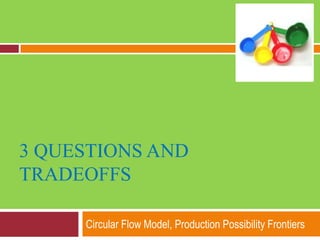How do we measure economic growth?
- 1. 3 questions and TradeoffsCircular Flow Model, Production Possibility Frontiers
- 2. The 3 questionsPeople seek to answer 3 questions when producing¡What do we produce?How do we produce?For whomdo we produce?
- 3. WHAT and HowLandLaborCapitalEntrepreneurshipWhat: Goods and ServicesHow: Factors of Production
- 4. WHAT? Top Services and Goods
- 5. For Whom?Land ? rent Labor ? wagesCapital ? interestEntrepreneurship ? profit/lossFOPs are paid income.Functional distribution of income
- 6. Personal Distribution of Income
- 7. The Circular Flow ModelA model of the economy that shows:the circular flow of expenditures and incomes that result from decision makers¡¯ choices and
- 8. the way those choices interact in markets to determine what, how, and for whom goods and services are produced.Households and FirmsHouseholdsIndividuals or people living together as decision-making units.FirmsInstitutions that organize production of goods and services.
- 9. MarketsMarketsA market is any arrangement that brings buyers and sellers together and enables them to get information and do business with each other.Factor marketsare markets in which factors of production are bought and sold.Goods marketsare markets in which goods and services are bought and sold.
- 10. Real FlowsIn factor markets:Households supply factors of production
- 11. Firms hire factors of production.In goods markets:Firms supply goods and services produced.
- 12. Households buy goods and services.Money FLOWSMoney FlowsFirms pay households incomes for the services of factors of production.Households pay firms for the goods and services they buy.
- 13. What are the possible decisions a firm can make?
- 14. PRODUCTION POSSIBILITIESProduction Possibilities FrontierA curve showing the combinations between two goods that can be produced using all available resources.
- 15. Figure 3.1 shows thePPF for bottled water and CDs. Each point on the graph represents a column of the table.The line through the points is the PPF. PRODUCTION POSSIBILITIES
- 16. We can produce at any point inside the PPF or on the frontier.Points outside the PPF such as point G are unattainable.The PPF separates attainable combinations from unattainable combinations.PRODUCTION POSSIBILITIES
- 17. 1. When production is on the PPF, such as at point E or D, production is efficient. 2.If production were inside the PPF, such as at point H, more could be produced of both goods without forgoing either good. Production is inefficient.PRODUCTION POSSIBILITIES
- 19. Moving from E to F, 1 bottle of water costs 5 CDs.OPPORTUNITY COST
- 21. How do you shift the curve?Improvements in productivityNew technologyNovel techniquesAn increase in the factors of productionAn increase in the workforceRise in the amount of capital¡°Shift it to the right ? productivity or novelty,Shift it to the left ? inefficiency¡±
- 22. Draw the following situation¡Costa Rica can produce bananas and coffee. During the last month, the country has made technological advances that led to a new, efficient method of planting crops. Draw and explain the impact of this advancement on both bananas and coffees.


















